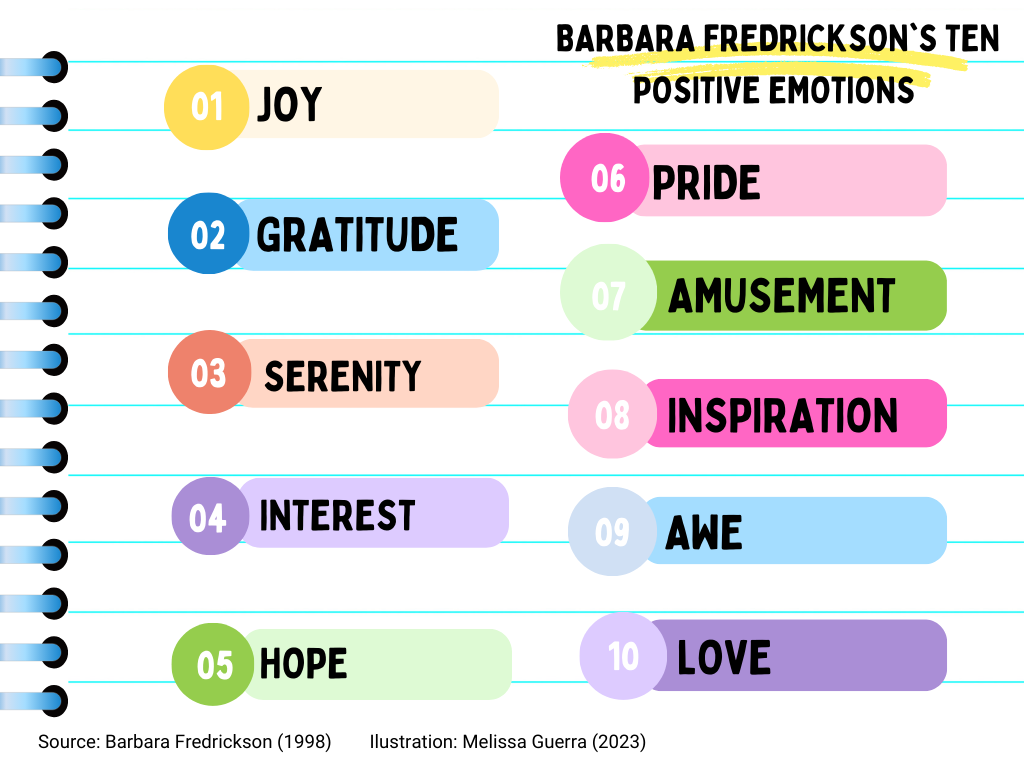Due to the COVID-19 pandemic, the concept of resilience, popularized by positive psychology, has been on everyone’s lips. However, in this post-pandemic world, not only is resilience necessary to move forward in this “new normal,” but an entire arsenal of weapons not available to many: positive emotions.
According to Barbara Fredrickson, ten trigger changes in our cognitive development to expand, transform, and build:

But how do our emotions help us daily? Many things can happen in a day. For example, we can wake up feeling encouraged or discouraged, energetic or tired; we may argue with someone at work and then encounter unfortunate situations at home. We can face these scenarios in various ways, but ideally, having adequate emotional intelligence to channel and resolve them would help us avoid overreactions that may hurt us and third parties.
In education, emotional intelligence is a topic little explored and applied within the classroom because the focus on the curriculum leaves aside essential aspects of a child’s growth, resulting in university students being unable to react well to stressful situations in their student, work, or personal life.
Therefore emotional learning becomes fundamental because it allows us to identify, understand, control, and effectively express emotions. It also creates awareness of them to act in the best possible way in any situation.
Importantly, all emotions work for our good. For example, a calming effect occurs after crying because the endorphins generate peace and well-being.
Therefore, sadness, anger, fear, and despair, although usually classified as “negative,” when properly managed (i.e., we know and identify what we feel), are easier to address since there is an internal awareness of what happens to us.
In this digitalization boom due to the pandemic, it is easy to lose a sense of reality because social networks are full of information (or misinformation), which instead of benefiting people, affects them negatively. Body dysmorphia is a simple but complex example; people with this illness perceive an alternative reality that does not exist (perfect bodies, perfect life), causing distortions for many young people that can have severe mental or physical health repercussions. The fashions and trends of social media have influenced behaviors, eating habits, and shopping, among others; That is why it is important to recognize and understand our emotions in the face of this “bombardment” of information.
Education also was impacted by the ravages of the pandemic. One study showed that, for students, the most significant change they had when migrating from face-to-face to an online format was communication; on the other hand, teachers felt that their biggest obstacle was the internet connection (with students’ attitude and communication being second and third).
Consequently, in both examples, communication was a common trait “lost” during the pandemic, but how is that possible? Although technology and the digital world “connect” us, they also disconnect us from who we are: sentient and conscious human beings with virtues and defects.
How does all this correlate with positive emotions? Straightforward, positive emotions generate well-being and personal growth. Therefore, strengthening self-esteem and the perception of achievement, for example, allows us to understand that we are valuable individuals who deserve respect and consideration; therefore, when we see a post on social media that may affect us, we can understand that much of that content is false and we do not have to feel emotionally bad. In education, this good self-esteem would manifest in the reflection that regardless of abilities, academic grades, or knowledge, each student is valuable for what he manages to do, eliminating the idea that a person only has value for what they do “successfully.”
Here are some suggestions for working on positive emotions internally:
- Be grateful and express gratitude.
- Be assertive.
- Develop empathy.
- Practice mindfulness.
- Act generously.
- Give constructive criticism.
- Take moments to reflect on your actions.
- Do not repress emotions.
- Pay attention to emotions and recognize them.
- Perform breathing exercises to relieve stress and anxiety.
How can I apply positive emotions in a virtual classroom?
It is essential to know that even when competencies such as organization, self-learning, adaptation, and technology-related skills were developed, skills such as communication, resilience, problem-solving, and literacy were severely affected during this period.
Therefore, the teacher must know that positive emotions and emotional intelligence play a considerable role in a virtual environment; humans are naturally social and require some “contact.” However, due to haste, adaptation, and other implications during the pandemic, education lost one of its fundamental bases: effective communication.
Positive emotions develop through various strategies, which are not exclusive to digital environments:
- Develop empathy and respect through spaces for reflection with students. These can apply in a project or dynamic depending on the subject or time.
- Implement mindfulness practices at some point during the day. You can begin the session week with mindfulness practice to release stress.
- Encourage constructive criticism among students and provide it as a teacher.
- Invite students to participate in social or sports activities in their community.
- Let students know at the beginning of the course what is expected of them and the rules of collaboration and teamwork to avoid subsequent conflicts that are usually attitudinal.
- Think “outside the box,” that is, implement surprise dynamics, such as trivia or quizzes, to boost humor and joy, perhaps through an app or website. These activities may relate to a topic they are studying to review key concepts.
- Strengthen students’ self-esteem and sense of achievement. Although class sizes can exceed 40 students, it is crucial to make an effort to let them know that they are valuable as individuals because they often do not have support at home.
Although these strategies may sound overwhelming, we can implement these measures little by little so that positive emotions flourish within the classroom throughout the school year. As teachers, the first pillar corresponding to us is showing interest, which can be evidenced by small actions to produce significant changes, for example, our preparation to teach our content (and expressing interest in it), presenting a good attitude, being punctual, adding dynamism and innovation in classes, among others. All this can favor better learning environments, whether face-to-face or virtual, and improve the student body’s attitude. Although we can have difficult classes, which can give us massive headaches, it is our vocation to be patient and share knowledge with others.
Another fundamental point is that regardless of the implementation strategies, these must always align with the educational level, skills, and the class’s personality; some may function better than others depending on these aspects. For example, we should not apply trivia with elaborate terms to encourage participation and empathy on a complicated topic (e.g., the war between Ukraine and Russia) to 1st-grade students in primary school because their skills and knowledge have not developed the maturity necessary to “land” that knowledge, understand it and apply it. Instead, we could make a trivia game (as a contest) with some topic familiar to the student (or some curricular content to know their opinions) and give the floor to their classmates and teach them that, with respect, tolerance, and patience, everyone can participate (promoting positive emotions and values).
Additionally, for university students, we could include relaxation practice (once a week) and discuss a social issue. We could also form interdisciplinary relationships and provide a different twist to a particular topic of our subject with another to promote positive values and emotions, reflect on an important date to celebrate during the month, etc. All this considering the subject, the availability of time, and the student interest, among others. The important thing is to perform various actions to obtain positive and different results.
“Everything you sow, you reap; everything you give, you receive.” It is time to reflect on the educational task and ask ourselves, “What am I planting? Do I like what I am receiving from my learners? What am I doing well in my teaching practice for virtual environments? How can I improve, and what is within my reach?”
“Educating the mind without educating the heart is not educating at all.”
– Aristotle
Translation by Daniel Wetta
This article from Observatory of the Institute for the Future of Education may be shared under the terms of the license CC BY-NC-SA 4.0 
)
)


)